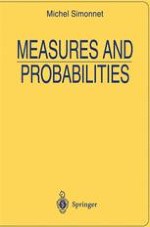1996 | OriginalPaper | Buchkapitel
The Fourier Transform in R k
verfasst von : Michel Simonnet
Erschienen in: Measures and Probabilities
Verlag: Springer New York
Enthalten in: Professional Book Archive
Aktivieren Sie unsere intelligente Suche, um passende Fachinhalte oder Patente zu finden.
Wählen Sie Textabschnitte aus um mit Künstlicher Intelligenz passenden Patente zu finden. powered by
Markieren Sie Textabschnitte, um KI-gestützt weitere passende Inhalte zu finden. powered by
14.1 In this section, we give some necessary and sufficient conditions for a quasi-measure, defined on the natural semiring of a nonempty open subset of Rk, to be a measure (Propositions 14.1.1 to 14.1.3).14.2 In Rk, the distribution function of a probability defined on the Borel σ-algebra is $$F:\left({{x_1}, \cdots {x_k}} \right) \mapsto P\left({\prod\nolimits_{1 \leqslant i \leqslant k} {\left] { - \infty, {x_i}} \right]}} \right)$$. A sequence of probabilities P n with distribution functions F n converges weakly to a probability P with distribution function F if and only if F n (x) converges to F(x) at every point of continuity of F.14.3 In this section, we define the covariance matrix of a positive measure of order 2 and the normal distribution N(m, σ2).14.4 Let μ be a bounded measure on the Borel σ-algebra of Rk. The Fourier transform of μ is the function ℱμ: x ↦ ∫exp(−2πixy)dμ(y). The function ℱμ is uniformly continuous and bounded (Proposition 14.4.1). Moreover, the Fourier transform is injective (Theorem 14.4.1). We next prove the Riemann—Lebesgue lemma: the Fourier transform of an integrable function vanishes at infinity. Finally, we prove the inversion theorem for bounded measures and two convergence theorems of fundamental importance in the theory of probability.14.5 This section is devoted to a short study of the normal laws in Rk.
